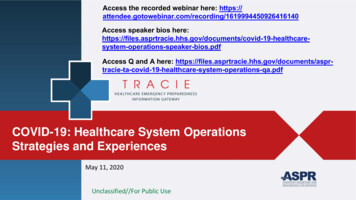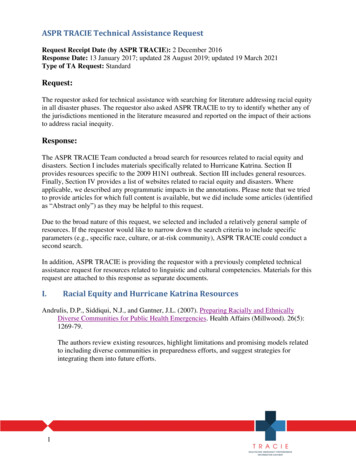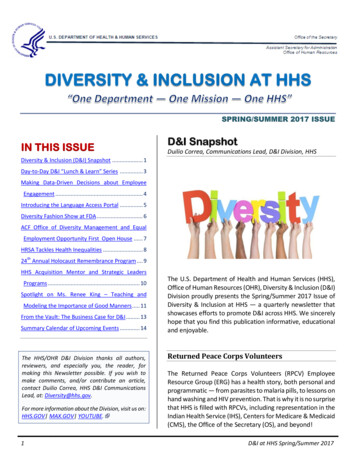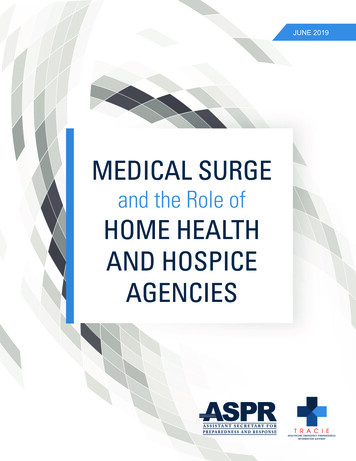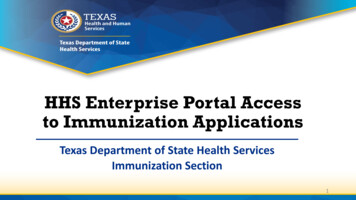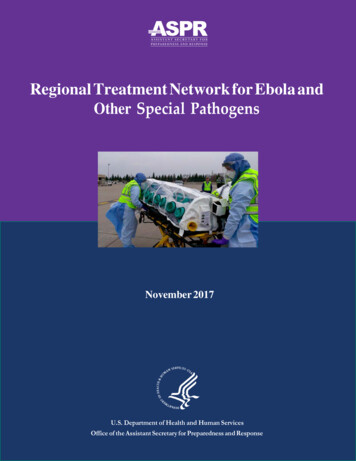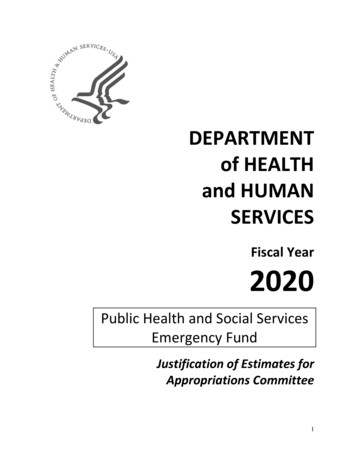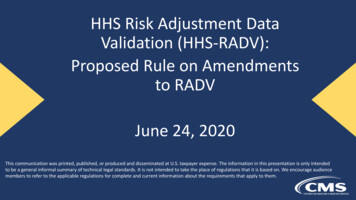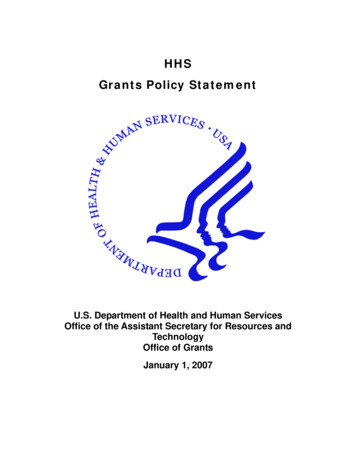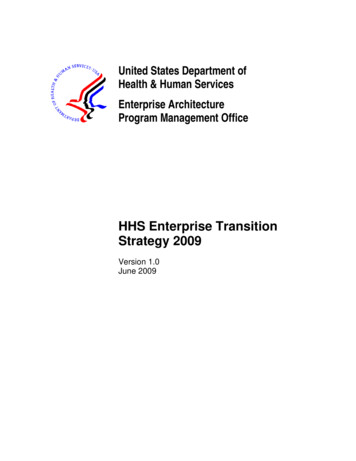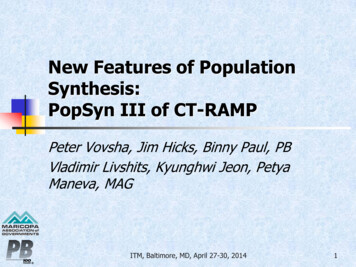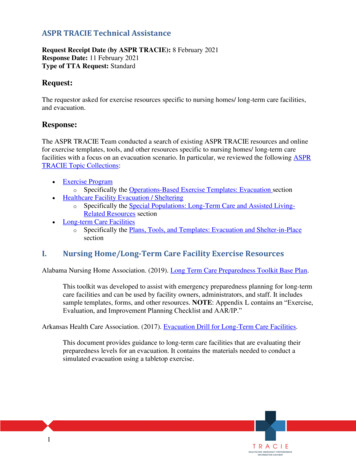
Transcription
ASPR TRACIE Technical AssistanceRequest Receipt Date (by ASPR TRACIE): 8 February 2021Response Date: 11 February 2021Type of TTA Request: StandardRequest:The requestor asked for exercise resources specific to nursing homes/ long-term care facilities,and evacuation.Response:The ASPR TRACIE Team conducted a search of existing ASPR TRACIE resources and onlinefor exercise templates, tools, and other resources specific to nursing homes/ long-term carefacilities with a focus on an evacuation scenario. In particular, we reviewed the following ASPRTRACIE Topic Collections: I.Exercise Programo Specifically the Operations-Based Exercise Templates: Evacuation sectionHealthcare Facility Evacuation / Shelteringo Specifically the Special Populations: Long-Term Care and Assisted LivingRelated Resources sectionLong-term Care Facilitieso Specifically the Plans, Tools, and Templates: Evacuation and Shelter-in-PlacesectionNursing Home/Long-Term Care Facility Exercise ResourcesAlabama Nursing Home Association. (2019). Long Term Care Preparedness Toolkit Base Plan.This toolkit was developed to assist with emergency preparedness planning for long-termcare facilities and can be used by facility owners, administrators, and staff. It includessample templates, forms, and other resources. NOTE: Appendix L contains an “Exercise,Evaluation, and Improvement Planning Checklist and AAR/IP.”Arkansas Health Care Association. (2017). Evacuation Drill for Long-Term Care Facilities.This document provides guidance to long-term care facilities that are evaluating theirpreparedness levels for an evacuation. It contains the materials needed to conduct asimulated evacuation using a tabletop exercise.1
California Association of Health Facilities. (n.d.). Disaster Preparedness Program Exercises andDrills. (Accessed 2/11/2021.)This webpage provides a number of resources for healthcare facilities (including longterm care facilities) regarding drills, tabletop exercises, after action reports andimprovement plan templates, and training resources. It was developed to assist healthcarefacilities to comply with the new Centers for Medicare & Medicaid (CMS) EmergencyPreparedness (EP) Rule. Other resources on this website include guidance forpreparedness and response plans, hazard vulnerability assessments, and recovery.California Association of Health Facilities. (2017). Safe Evacuation Table Top Exercise for LongTerm Care Facilities.This guidebook is designed to help long-term care facilities evaluate their preparednessfor an evacuation. It contains the materials necessary to conduct a simulated evacuationusing a tabletop exercise. The evacuation drill is detailed in four steps and includesmultiple templates and forms.District 1 [Michigan] Regional Medical Response Coalition. (2010). Situation Manual: ShelterIn-Place/Evacuation Tabletop Exercise: Long Term Care Facility.This Situation Manual includes exercise materials from Michigan, where exerciseparticipants were given the tools to implement and evaluate a long-term care facilitytabletop exercise. The purpose of this exercise was to provide a forum for long-term carefacilities and other organization to participate in a facilitated discussion regarding theirroles and responsibilities during shelter-in-place and evacuation emergencies.Florida Healthcare Association, Florida Department of Health, and Emory University. (n.d.).Florida Long Term Care Emergency Preparedness Portal. (Accessed 2/11/2021.)This website includes tools and resources on emergency preparedness topics specificallyfor skilled nursing and post-acute care centers. It provides a list of resources for planningand response preparedness, trainings and exercises, and disaster recovery. NOTE: Undertrainings and exercises, there are example tabletop exercises, videos for training staff, andchecklists.Florida Healthcare Association, Florida Department of Health, The John A. Hartford Foundation,University of South Florida. (2008). Emergency Preparedness Training and ExerciseGuide for Nursing Homes.This guide was developed to help nursing homes design and maintain a preparednesssystem (plans, training, and exercises). It provides a step-by-step process for planning anexercise that is Homeland Security Exercise and Evaluation Program (HSEEP)compliant) and provides exercise examples (including planning worksheets, samples,etc.).2
Health Care Association of New Jersey. (2012). Mid Summer’s NightMARES: SituationManual.This Situation Manual provided exercise participants in New Jersey with the tools toimplement and evaluate the tabletop exercise related to long-term care facilities. Thepurpose of this exercise was to provide participants with an opportunity to evaluate theirlong-term care facility’s current medical surge capabilities in response to a severeweather event. It focused on the implementation and coordination of internal emergencymanagement plans, policies and procedures, critical decision making, communicationscapabilities and the ability to manage a disaster situation requiring medical surge orevacuation of residents into the facility’s operations.Health Care Association of New Jersey. (2012). Project ESCAPE (Evaluate Surge Capacity andPrioritized Evacuation) Full Scale Exercise: After Action Report/Improvement Plan.This after action report provides a summary of the Central West Medical CoordinationCenter regional mass casualty exercise. Organizers developed two objectives for thisexercise: evaluate the ability to evacuate residents from a long-term care facility andevaluate medical surge into an acute care hospital. This document can also serve as atemplate for other community exercises.Michigan Region 6. (2010). Evacuation Drill for Long Term Care Facilities.This guidebook is designed to help long-term care facilities evaluate their preparednessfor an evacuation. It contains the materials necessary to conduct a simulated evacuationusing a tabletop exercise.New York City Department of Health and Mental Hygiene, and The Brookdale Center forHealthy Aging and Longevity of Hunter College/ CUNY. (2011). Adult Care EmergencyPreparedness Exercise Toolkit.This toolkit provides adult care providers with templates and resources to develop andconduct emergency preparedness exercises. It includes the following: exercisedevelopment checklist, job aids/ needs assessment, options for selecting the right exercisefor your organization, a narrative sample, and an after action report template.New York State Department of Health. (2011). Nursing Home Evacuation Plan.This workbook provides considerations for nursing home facilities that are developing orupdating their evacuation plans. It is intended to be used in any emergency requiringeither a full or partial evacuation of the nursing home.Orange County California. (2018). 2018 Statewide Medical and Health Exercise.This webpage includes links to exercise documents for Orange County’s (CA)participation in the 2018 statewide medical and health exercise (infectious diseasescenario). Included are the Exercise Plan, Master Scenario Events List (MSEL),Participant Feedback Form, Controller/Evaluator Handbook, and setting-specific3
objectives and evaluation guides, including those for hospitals, long-term care and skillednursing facilities, and clinics and dialysis centers.Primary Care Emergency Preparedness Network. (n.d.). Community Health Center CoastalStorm Exercise Plan. (Accessed 2/11/2021.) New York City Department of Health andMental Hygiene.This HSEEP-compliant full-scale/functional exercise planning tool can help plannersdevelop a hurricane-specific, operations-based exercise for community health centers. Itmay be referenced by other healthcare facilities for developing similar exercises.Santa Barbara County Public Health Department. (2018). 2018 Extended Power OutageExercise.This webpage includes links to Santa Barbara County’s exercise materials, includingobjectives and exercise forms, for the annual statewide full-scale exercise held inCalifornia. The scenario for the 2018 exercise was an extended power outage withevacuations.Shakeout. (n.d.). ShakeOut Exercise Manual For Healthcare Organizations. (Accessed2/11/2021.)This document provides guidance for healthcare facilities that wish to participate in aShakeOut (earthquake) exercise in their community. It includes checklists to guideplanning for a drill, a tabletop exercise, and a functional exercise.Wisconsin Department of Health Services. (2018). CMS Emergency Preparedness Rule Toolkits.This webpage includes links to toolkits and other resources designed to help selecthealthcare facilities better understand the CMS EP Rule. There is both a PDF (toolkit)and Word version (workbook) for each facility type, and the relevant CMS rules for eachfacility type are included. Each toolkit includes sample templates and planningworksheets that can help facilities develop compliant plans, policies, and procedures.NOTE: Click on the “Long-Term Care/ Skilled Nursing Facilities” tab towards thebottom of the web page. A workbook is provided in an editable Word format. Inparticular, page 22 includes training and testing checklists, evaluation guide, and afteraction report template.II.Other Relevant ResourcesCalifornia Association of Health Facilities (n.d.). Long-Term Care Facility Evacuation: PlanningConsiderations. (Accessed 2/11/2021.)This resource provides suggested emergency operations plan components for theevacuation of long-term care facilities. Provided in tabular form, it lists evacuationcategories in one column and suggested responses and best practices in another. Itincludes general and evacuation provisions, and physical plant, re-entry, and otherconsiderations for widespread evacuation.4
California Association of Health Facilities (2012). Long-Term Care Facility Evacuation ResidentAssessment Form for Transport and Destination.This document is an assessment form for residents of long-term care facilities who needto be evacuated and transported in an emergency. It provides information about threelevels of care, facility type, transport type, and number of residents.Centers for Medicare and Medicaid Services, Survey and Certification Group. (2009). HealthCare Provider After Action Report/Improvement Plan (AAR/IP).This resource provides an AAR/IP template and instructions for completion. It isintended to be a user-friendly tool for healthcare providers to document their performanceduring emergency planning exercises and real emergency events. It is also used to makerecommendations for improvements for future performance. The AAR/IP template ismodeled after the U.S. Department of Homeland Security’s HSEEP Vol. III AAR/IP,which was issued in February 2007.Federal Emergency Management Agency. (n.d.). HSEEP Policy and Guidance. (Accessed2/11/2021.)This website contains links to templates emergency planners can tailor for exerciseprogram management, design and development, conduct, evaluation, and improvementplanning. A link to exercise evaluation guides is also provided.Florida Health Care Association. (2008). National Criteria for Evacuation Decision-Making inNursing Homes. Florida Health Care Education and Development Foundation.This resource provides criteria for evacuation decision-making in nursing homes and isintended to assist administrators and healthcare professionals determine whether toevacuate or shelter-in-place during disasters. It also includes guidance on the evacuationprocess.Greater New York Hospital Association. (2017). Patient Evacuation Toolkit.This toolkit contains resources developed by the "Patient Movement Workgroup" andaddresses four priority areas: defining bed types to make bed matching easier; sharingcritical information during transport; improving access to medical records after patienttransfer; and best practices for credentialing healthcare personnel. It also includesinformation on Transportation Assistance Levels (stretcher, wheelchair, and ambulatory)and a downloadable job aid worksheet (p. 10).5
Feb 11, 2021
